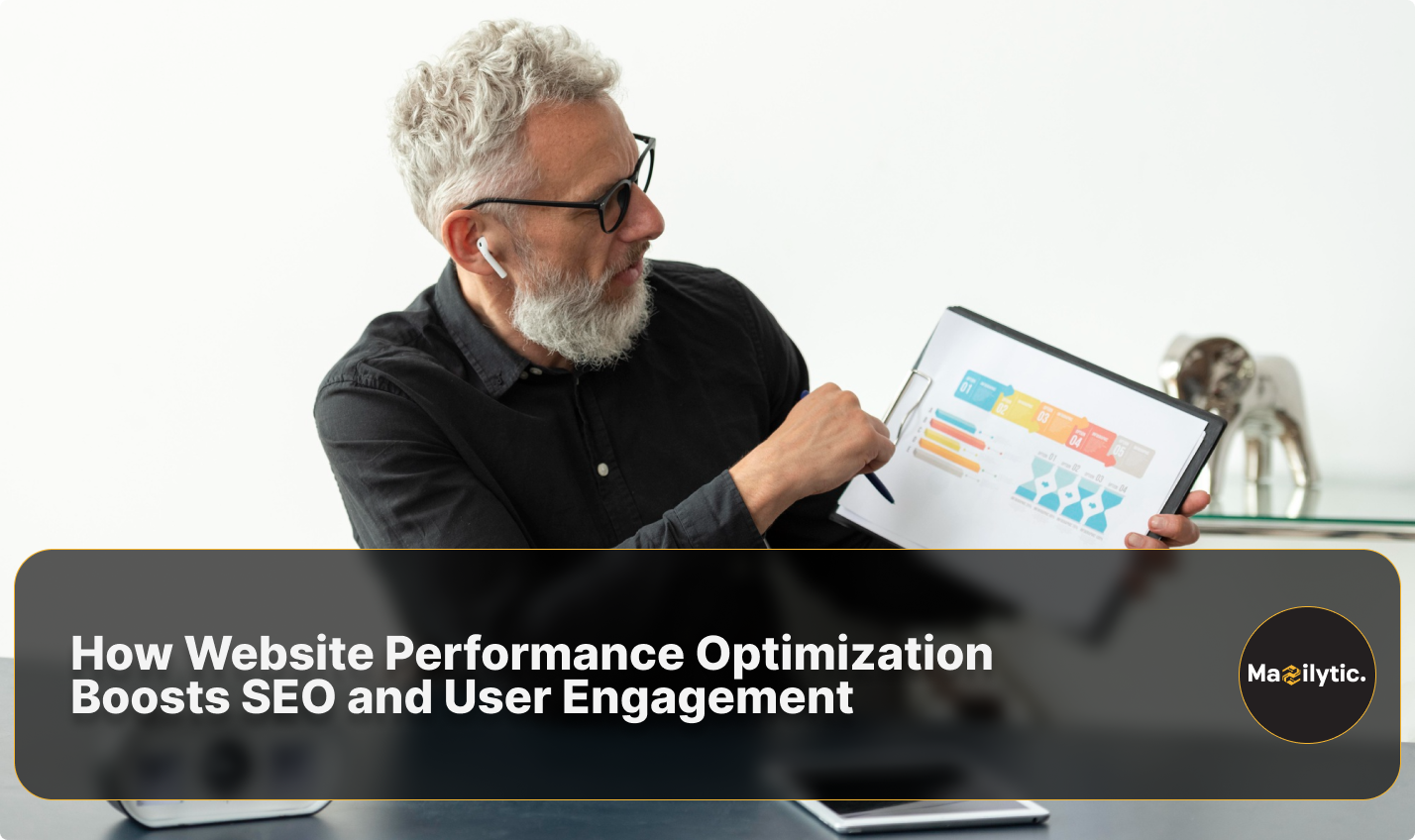
How Website Performance Optimization Boosts SEO and User Engagement
Introduction
For online success in today’s ‘fast-paced’ digital age, website performance optimization is essential. In an instant, people want information, and this is why people prefer websites that load quickly and can easily be used to rank search engines such as Google highly. Visitors will get irritated; bounce rates go up and buyers may move elsewhere.
But performance optimization doesn’t just mean speed, it’s a complete cycle turning the whole User Experience (UX), it also guarantees best practices SEO and best performance at crucial points such as Page Load Speed and Core Web Vitals. By managing these factors, businesses can improve search exposure and increase their conversion rates and the outlook for customers.
This is a comprehensive article that discusses the pros of SEO and optimization as well as provides practical tips that follow the emerging industry standards while examining the profound influence of Website Performance Optimization on SEO and user engagement.
The Relationship Between Website Performance Optimization and SEO
Why Website Speed Matters for SEO
Because page load speed has a direct effect on a user experience, Google considers page load speed as a vital ranking factor. However, some websites have slow loading times and a higher bounce rate, for example, visitors leave without viewing. This behavior marks the information as off topic which consequently ranks lower.
Important Factors Affecting Website Speed SEO
Lower Crawl Budget: When indexing webpages, search engines set aside a crawl budget. Fewer pages are crawled and indexed on a sluggish website.
Reduced Search Rankings: Websites that load in less than three seconds are given preference by Google’s algorithms.
Increased Bounce Rates: Users tend to get frustrated and give up due to slow loading time.
Tips for Optimization:
- Make use of browser caching.
- Minify HTML, CSS, and JavaScript.
- Reduce the size of images without compromising quality.
Case Study: Pinterest reduced perceived wait times by 40% and increased search engine traffic and sign-ups by 15% by enhancing performance.
Core Web Vitals: Google’s Performance Benchmark
Google created a set of standardized measurements called Core Web Vitals to evaluate the actual user experience. These consist of:
- Largest Contentful Paint (LCP): This measures the loading performance; the target time is less than 2.5 seconds.
- First Input Delay (FID): Interactivity is measured by the FID. This needs to be less than 100 ms.
- Cumulative Layout Shift (CLS): It evaluates the visual stability, which ought to be less than 0.1.
Why Core Web Vitals Matter:
Because they provide a more seamless surfing experience, websites that meet these standards are more likely to rank higher. Reduced search visibility and engagement are the results of poor Core Web Vitals.
Tips for Optimization:
- Make use of quicker hosting options.
- Use sluggish loading when it comes to images.
- Improve the speed at which servers respond.
Real-World Impact: According to Google, consumers were 24% less likely to quit pages on websites that met core web vitals.
How Website Performance Optimization Improves User Engagement
Enhanced User Experience (UX) Retains Visitors
When it comes to the User Experience (UX) of a website, the faster and easier it is to use it, the more related to its speed. If a website loads quickly and behaves well then one can navigate more pleasantly and that’s conversions.
Important Techniques for UX Optimization:
- Rely on responsive design so that the app works smoothly on desktops, tablets, and mobile devices.
- The navigation should be simplified, and users should be able to find what they need most with three clicks.
- Interactive features like Chatbots, CTAs, and quickly loading forms increase user engagement.
Insight: Conversion rates might drop by as much as 20% when mobile load times are delayed by one second. Retaining mobile customers, who now account for most of the web traffic, require performance on all devices.
Page Load Speed: A Driver of Conversions
The slightest slowdown in page load speed can significantly lower conversion rates, which can cost e-commerce firms thousands of dollars in lost sales. Major retailers have clear proof that page load speed has a major impact on online sales.
- Amazon estimated that just 100 milliseconds of delay could cost them billions of dollars annually with a 1% drop in sales.
- Walmart also saw a 2% increase in conversions for every single second and they improved their page load time, indicating the incontrovertible relationship between website speed and the conduct of customers making purchases with them.
The findings highlight how important it is that any online business seeks to augment precious revenue and customer satisfaction performance by carefully prioritizing page load times.
Ways of Optimization:
- For quicker content delivery, make use of CDNs.
- Make database queries more efficient.
- Cut down on broken links and redirects.
Pro Tip: To keep an eye on performance, do speed tests frequently using Google Lighthouse, Pingdom, or GTmetrix.
Reducing Bounce Rates with Performance Optimization
High bounce rates are frequently a sign of unhappy users. A slow website deters users from continuing to explore, which hurts SEO. Users are more likely to stay, interact, and convert when page loads are accelerated, and content consistency is maintained.
Methods to Lower Bounce Rates:
- Give Above-the-Fold Content Priority: Load the important content first.
- Optimize Media and Fonts: Make use of compressed media assets and system fonts.
- Ensure Mobile Optimization: Google uses mobile-first indexing, making mobile performance essential.
Practical Strategies for Comprehensive Website Performance Optimization
Optimize Web Hosting for Speed and Reliability
A website’s speed is significantly impacted by the hosting company that is selected. Performance can be slowed down by shared hosting, while dedicated or cloud hosting alternatives offer higher uptime and faster load times.
Recommended Host:
- Kinsta
- SiteGround
- WP Engine
Image and Media Optimization
Slow loading speeds are most often caused by large media files. Enhancing performance requires optimizing these resources.
Optimization Techniques:
- Make use of WebP and other next-generation formats.
- Turn on lazy loading to postpone off-screen visuals.
- Videos can be hosted externally or compressed.
Efficient Use of Caching
The method of caching helps improve website performance by saving copies of files so that it loads faster for repeat users. This helps server workload reduce and fast user experience.
Various kinds of caching exist: Browser caching allows for quicker retrieval of website resources on subsequent visits by storing them directly on the user’s browser. Less server processing load is relieved by server-side caching by just providing cached files via the server. Also, to reduce latency to consumers all over the world, it uses a network of internationally distributed servers for content delivery network (CDN) caching, which guarantees quick delivery to users no matter where they’re located.
Minify CSS, JavaScript, and HTML
Performance can be increased by eliminating redundant code, whitespace, and comments.
Tools for Minification:
- UglifyJS (JavaScript)
- CSSNano (CSS)
- HTMLMinifier (HTML)
Leverage Modern Web Technologies
Incorporate advanced web technologies to streamline performance.
- HTTP/3 for faster connections.
- Progressive Web Apps (PWAs) for app-like experiences.
- Accelerated Mobile Pages (AMP) for lightning-fast mobile performance.
The Long-Term Impact of Website Performance Optimization
- Improved Search Visibility
Improved performance raises a website’s search engine rankings and increases its discoverability. Regular speed enhancements also stop algorithm upgrades from causing ranking swings.
- Higher User Retention and Loyalty
Users are more likely to visit dependable, quick websites again. Website performance optimization improves brand perception and fosters loyalty and trust.
- Enhanced Accessibility and Inclusivity
Users with impairments can access websites more easily when they are quick and well-organized. Using the best practices for accessibility also improves SEO and expands the audience.
Conclusion: Make Optimizing Website Performance a Priority for Long-Term Growth
Website performance optimization is necessary to increase website rank in search results and enhance click-through rate. This ensures that with appropriate performance optimization, it will aid in successful performance on the internet by attaining Core Web Vitals and improving Page Load Speed as well as satisfying the required User Experience (UX).
All these tactics when followed can help businesses attract, engage, and even keep users, and this is possible through media compression, effective caching, Website Speed Optimization, and using contemporary technologies.
Final Thought: In a time when brand perception is shaped by digital experiences, Website Performance Optimization has become a competitive need rather than a luxury. To keep your website quick, easy to use, and search engine friendly, test, adjust, and optimize it frequently.






